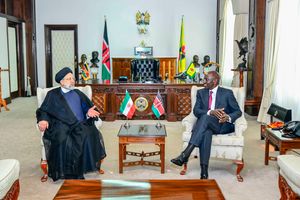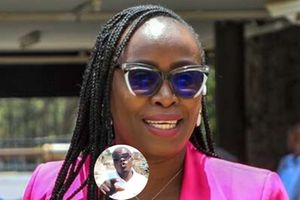Little known community museum underscores need for peace

Curator Lydia Wangari at the Peace Museum in Nyeri. Photo/ JOSEPH KANYI
What you need to know:
- There are many priceless artifacts of yore in the Museum located just a few meters from the Kenya National Library in Nyeri but some words of wisdom on the walls of the Museum subtly underline the vision of its founder.
- “Mbaara ti uchuru,” is a Kikuyu proverb written on the wall near the photos of the elders underscoring the need for peace. The proverb translates to ‘war is not porridge.’
- The Museum charges Sh100 for local visitors, Sh50 for children and Sh500 to foreign visitors. The curator however welcomes people to come and learn even if they have no money.
The search for lasting peace is as old as mankind and many have given up their lives in the quest for peace and yet mankind will never tire in the elusive search.
It is this quest which informed Kariuki Thuku to establish a peace museum in Nyeri in order to preserve for posterity, the memories of those before him who dedicated their lives in the quest for peace.
With limited resources, the founder started a small museum at Itara Garden Park Hotel in 1997. Many teachers, departmental heads in the Ministry of Education, Ministry of Culture and Social Services and students visited.
A considerable number of schools brought their students for educational trips to the mini-museum.
MUSSUEM TOO SMALL TO ACCOMMODATE LARGE NUMBERS
However in 1999, the Museum suspended temporarily the schools’ group visits due to space inhibitions.
The museum was too small and the schools were bringing very huge groups of students at once. The idea to construct a huge museum was conceptualised.
With assistance from an organisation that fosters global peace initiatives, the Museum managed to develop and upgrade to a spacious facility a few meters from Itara Garden Park Hotel and behind the Nyeri National Library.
Though Mr Thuku, who was the founder of the Agikuyu Peace Museum and Resource Center passed away four years ago, the Museum which is now under a new curator Ms Lydia Wangare stands as a testimony to the ideals cherished by the deceased founder.
PRICELESS ARTIFACTS
There are many priceless artifacts of yore in the Museum located just a few meters from the Kenya National Library in Nyeri but some words of wisdom on the walls of the Museum subtly underline the vision of its founder.
“When the Power of Love overcomes the Love of Power, the world will know peace,” is one such quote and though the current curator Ms Wangare attributes the quote to the founder of the Museum, the wisdom in the words sounds like something straight from the mouth of renown peace crusaders like Mahatma Gandhi or the American Martin Luther King.
The wooden-built storey Museum which is painted with zebra colours has three sections; the Peace Material Culture museum which is also known as the ‘Kiama Section,’ the ‘Mukwa’ section which Ms Wangare says is a sub-culture on women health and the peace tree garden outside the building.
‘WAR IS NOT PORRIDGE’
The Kiama section contains photos of various elders who were peacemakers in the Agikuyu community.
There is a photo of Chief Kariuki wa Gakure from Murang’a who was born in the year 1840.There is also a Photo of Kinyanjui wa Gathirimu from Kiambu who was born in the same year with Chief Gakure among other elders. The photos were taken in the 1920s.
“Mbaara ti uchuru,” is a Kikuyu proverb written on the wall near the photos of the elders underscoring the need for peace. The proverb translates to ‘war is not porridge.’
There is also another saying which paints a vivid picture of what happens during war:
“In times of war, fathers bury their sons and in times of peace, sons bury their fathers.”
Ms Wangare says the Agikuyu Peace Museum has helped in establishing other peace museums in various communities.
“My Museum is the mother of other peace museums throughout the country including the Aembu, the Ameru and the Abagusii peace museums,” said Ms Wangare.
Ms Wangare says she has worked with curators from more than 10 communities to help establish their museums.
The curators hold workshops like a recent one which was dubbed ‘journeys of peace’.
The workshops mostly target young people in order to make them understand the mechanisms of peace and conflict resolution.
The curators also involve community elders in their activities like the ‘Healing of the Earth’ ceremonies which are meant to cleanse massacre sites contaminated by the shedding of blood.
EMPHASIS ON DIALOGUE
The peace museum emphasises on dialogue as a means of conflict-resolution.
“We have curators from different communities with several elders who are consulted in conflict resolution,” says Ms Wangare.
The Museum has in the past received visitors from Sweden, Netherlands, and USA among other local and foreign visitors.
Founded in 1997 the museum has gone through both good and lean times especially after the death of the founder but now the current curator says the interest in the museum has been revived with the establishment of the county governments.
The setting up of Universities like Karatina and Dedan Kimathi has also led to a growing interest in the museum with scholars visiting to sample the material culture in the museum.
‘COME AND LEARN IF UNABLE TO PAY ENTRANCE FEE’
The Museum charges Sh100 for local visitors, Sh50 for children and Sh500 to foreign visitors. The curator however welcomes people to come and learn even if they have no money.
Ms Wangare says she receives an average of 60 visitors every month and some times the number is higher as schools and college students come in busloads. The Museum has also introduced ‘Peace Clubs’ in various schools within the Mt Kenya region.
Among the artifacts in the museum are ancient collections like the ‘muura’ a sort of a pressure pump which was first used by the Indians and later by Agikuyu blacksmiths to light fire.
The colonial passbook, buffalo head skull, jiggles; an ostrich egg and a Bible covered with animal hide are some of the relics of the past treasured in the museum.
The curator says it is important to preserve a culture that is dying for the sake of future generations especially for those brought up in urban centres.
The Museum is planning to have ‘peace tourism’, activities soon with some pastoral communities in Kenya who have been involved in conflict.
And as expected of any museum in Kenya, the picture of Liberation Hero Field Marshal Dedan Kimathi hangs on the wall with the caption: ‘Good men must die but death cannot kill their names.’





